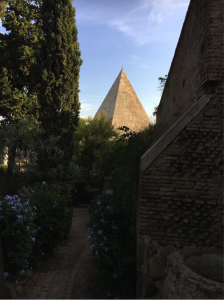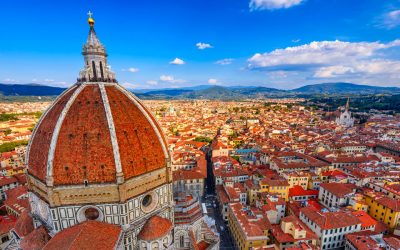This post comes to us from Christopher Moore. Christopher is currently studying Art History in Rome, Italy. He is studying abroad with API from Emmanuel College.
It’s been called “the holiest place in Rome” by Oscar Wilde. The English poet, Percy Bysshe Shelley, wrote, “It might make one in love with death, to think that one should be buried in so sweet a place.” A year later after making that remark, Shelley drowned in a storm off the shores of the Italian Riviera. His wish was granted. In 1822, he was buried in the Protestant Cemetery of Rome. Yes, perhaps he was too much in love with the idea of death.
While walking to the cemetery on a warm October morning, a startling thought occurred to me. I was, at that point in time, walking to a cemetery for the express purpose of actually going to a cemetery. This wasn’t your typical study abroad adventure. This past summer, I can’t say I was imagining myself roaming around Rome looking for a graveyard.
But in my defense, the Protestant Cemetery is not your typical burial site. If you love cats, pyramids, sculptures of grief-stricken angels, and the poetry of John Keats, then this cemetery – God, I can’t believe I’m saying this – will be right up your alley. (Cue reader that says: “I’ve always dreamed of such a graveyard, what a discovery this is!”).
OK, I’ll admit it, I was excited about going to a graveyard. My enthusiasm became even more ardent when I became aware of the exact location of the cemetery and its proximity to ancient Roman sites and ruins. It overlooks the Pyramid of Cestius, built in 12 BC during Rome’s wave of Egyptomania as a result of winning the great naval victory at Actium that destroyed the forces of Marc Antony and Cleopatra. To the right of the pyramid lies the ancient city gate, Porta San Paolo. And acting as a boundary for much of the cemetery, a section of the Aurelian Wall runs along it. You certainly can’t say this cemetery doesn’t have a stunning backdrop.
The Protestant Cemetery originated in 1716 by a decree from Pope Clement XI allowing exiled members of the Stuart Court from England to be buried in unconsecrated ground in Rome. It also served as a final resting place for wayward British noblemen on the Grand Tour. But over the centuries, the graveyard has contained people of numerous faiths besides Protestants, such as Orthodox Christians, Jews, Muslims, and Buddhists.
Yet, in addition to Shelley, this cemetery is best known for being the final resting place of Shelley’s fellow friend and poet, John Keats. In 1821, Keats was buried here. (The second generation of English Romantic poets; Keats, Shelley, and Byron, all died in the 1820s.) Convinced that his poetry would never be remembered, Keats’ headstone reads, “This grave contains all that was mortal of a young English poet, who on his deathbed, in the bitterness of his heart, at the malicious power of his enemies, desired these words to be engraved on his tombstone: Here lies one whose name was writ in water.” Like many other artists, Keats’ death was seemingly a prerequisite for fame.
Earlier I mentioned cats. The Protestant Cemetery is home to one of Rome’s two cat sanctuaries (the other can be found at Largo di Torre Argentina, the site of Julius Caesar’s assassination). This burial site, steeped in history, takes on a whole new meaning when cats are present.
Though, more than anything else, the cemetery is simply captivating. When entering it, you’re suddenly surrounded by cypress trees, flowers, amphora, sculptures, and headstones with inscriptions that speak from across the ages. The noise and chaos of Rome dissipates. Amidst the splendid greenery, you’re transported back in time. Before you know it, you realize that this is not a dead, but an alive space. Prosaic, this place is not.
Oscar Wilde was right. The Protestant Cemetery is Rome’s most sacred space. As I’m leaving the cemetery, I glance back at the sea of graves. I think to myself: only in Rome could I find such a place.






